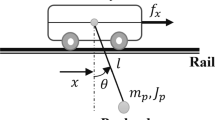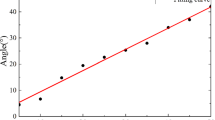Abstract
In this paper, the derivation of partial velocity in analytic form is illustrated. Then, the relation between Euler–Lagrange formulation and Kane principle formulation is presented. However, it ignores the condition that resultant moment of active force acts on end-effector. Under this circumstance, Kane principle formulation is further extended. It only considers velocity parameters instead of inertia tensor. The planar redundant manipulator with 5 degrees of freedom is taken as a case to verify the correctness of improved Kane principle formulation. By comparing torques under different methods based on experiment, Euler–Lagrange formulation, and Kane principle formulation, results confirm the importance and the nonlinear form of compensation coefficient in the dynamic model. Additionally, based on improved Newton–Euler formulation and improved Euler–Lagrange formulation, approximated dynamic models reflect that the accuracy of improved Kane principle formulation. Finally, improved Kane principle formulation provides a new method of establishing approximated dynamic models, which can justify whether trajectories in Cartesian space and joint space are reasonable.







Similar content being viewed by others
References
L. Carbonari, Simplified approach for dynamics estimation of a minor mobility parallel robot. Mechatronics 30, 76–84 (2015)
H.B. Choi, A. Konno, M. Uchiyama, Inverse dynamics analysis of a 4-d.o.f. parallel robot H4. Adv. Robot. 24(1–2), 159–177 (2010)
J. Wu, J.S. Wang, L.P. Wang, T.M. Li, Dynamics and control of a planar 3-DOF parallel manipulator with actuation redundancy. Mech. Mach. Theory 44(4), 835–849 (2009)
R.M.M. Orsino, T.A.H. Coelho, C.P. Pesce, Analytical mechanics approaches in the dynamic modelling of Delta mechanism. Robotica 33(4), 953–973 (2015)
R. Vidoni, A. Gasparetto, M. Giovagnoni, Design and implementation of an ERLS-based 3-D dynamic formulation for flexible-link robots. Robot. Cim. Int. Manuf. 29(2), 273–282 (2013)
O. Altuzarra, A. Zubizarreta, I. Cabanes, C. Pinto, Dynamics of a four degrees-of-freedom parallel manipulator with parallelogram joints. Mechatronics 19(8), 1269–1279 (2009)
Y.G. Liu, Y.M. Li, Dynamics and model-based control for mobile modular manipulators. Robotica 23, 795–797 (2005)
J. Bernal, R. Campa, I. Soto, Kinematics and dynamics modeling of the 6-3-PUS-type Hexapod parallel mechanism. J. Mech. Sci. Technol. 32(10), 4555–4570 (2018)
R.P. Judd, D.R. Falkenburg, Dynamics of nonrigid articulated robot linkages. IEEE Trans. Autom. Control 30(5), 499–502 (1985)
X. Li, H.X. Sun, L.J. Liao, J.Z. Song, Establishing an improved Kane dynamic model for the 7-DOF reconfigurable modular robot. Math. Probl. Eng. 2017, 1–13 (2017)
H.X. Wei, T.M. Wang, M. Liu, J.Y. **ao, Y.D. Li, Inverse dynamic modeling and analysis of a new caterpillar robotic mechanism by Kane’s method. Robotica 31, 493–501 (2013)
C. Laura, L. Raffaele, New results on robot modeling and simulation. J. Dyn. Syst. Meas. Control 128(4), 811–819 (2006)
V. Falkenhahn, T. Mahl, A. Hildebrandt, R. Neumann, O. Sawodny, Dynamic modeling of bellows-actuated continuum robots using the Euler–Lagrange formalism. IEEE Trans. Robot. 31(6), 1483–1496 (2015)
P. Sanchez-Sanchez, M.A. Arteaga-Perez, Simplied methodology for obtaining the dynamic model of robot manipulators. Int. J. Adv. Robot. Syst. 9, 1–12 (2012)
X. Li, X.F. Wang, J.H. Wang, A kind of Lagrange dynamic simplified modeling method for multi-DOF robot. J. Intell. Fuzzy Syst. 31(4), 2393–2401 (2016)
C.F. Yang, J.W. Han, S.T. Zheng, O.O. Peter, Dynamic modeling and computational efficiency analysis for a spatial 6-DOF parallel motion system. Nonlinear Dyn. 67(2), 1007–1022 (2012)
C.A. Cheng, H.P. Huang, H.K. Hsu, W.Z. Lai, C.C. Cheng, Learning the inverse dynamics of robotic manipulators in structured reproducing kernel Hilbert space. IEEE Trans. Cybern. 46(7), 1691–1703 (2016)
B. **ao, S. Yin, O. Kaynak, Tracking control of robotic manipulators with uncertain kinematics and dynamics. IEEE Trans. Ind. Electron. 63(10), 6439–6449 (2016)
A.A. Carlos, R.C. Ricardo, P.G. Sergio, M.V. Javier, Effects of nonlinear friction compensation in the inertia wheel pendulum. J. Mech. Sci. Technol. 31(9), 4425–4433 (2017)
J. Boisclair, P.L. Richard, T. Laliberte, C. Gosselin, Gravity compensation of robotic manipulators using cylindrical Halbach arrays. IEEE-ASME Trans. Mech. 22(1), 457–464 (2017)
S. Kim, S. Kwon, Dynamic modeling of a two-wheeled inverted pendulum balancing mobile robot. Int. J. Control Autom. 13(4), 926–933 (2015)
O. Rios, Method of influence coefficients for kinematic and dynamic modeling of robotic systems. IEEE Trans. Robot. 32(1), 236–245 (2016)
L.C. Yu, K.Q. Wang, Z.G. Zhang, Q.H. Zhang, J.H. Zhang, Simulation-based multi-machine coordination for high-speed press line. J. Braz. Soc. Mech. Sci. Eng. 41(7), 1–10 (2019)
L.C. Yu, K.Q. Wang, Q.H. Zhang, J.H. Zhang, Trajectory planning of a redundant planar manipulator based on joint classification and particle swarm optimization algorithm. Multibody Syst. Dyn. 50, 25–43 (2020)
Funding
The authors have not disclosed any funding.
Author information
Authors and Affiliations
Corresponding author
Ethics declarations
Conflict of interest
The author declares that there is no conflict of interest. The author reads and approves the final manuscript.
Additional information
Publisher's Note
Springer Nature remains neutral with regard to jurisdictional claims in published maps and institutional affiliations.
Rights and permissions
About this article
Cite this article
Yu, L. An Effective Compensation Strategy for Dynamic Model based on Improved Kane Principle Formulation. J. Inst. Eng. India Ser. C 103, 589–596 (2022). https://doi.org/10.1007/s40032-022-00836-6
Received:
Accepted:
Published:
Issue Date:
DOI: https://doi.org/10.1007/s40032-022-00836-6




